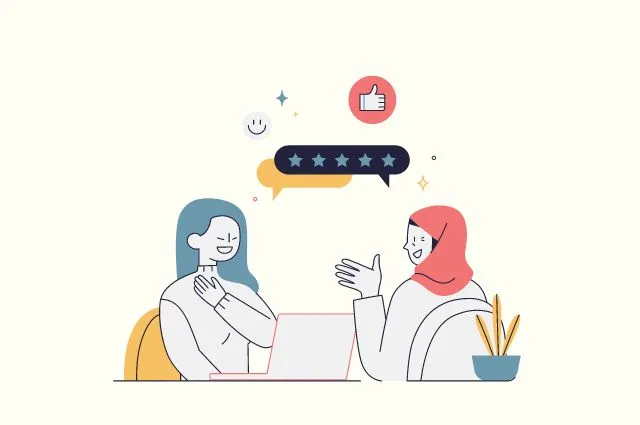
How to Handle a Difficult Customer?
Your customers are the most important asset for your business so you must treat them with respect. You can bring in new customers in business with one-of-a-kind products, unique gifts, or by lowering your prices. But if you don’t build relationships with your customers, they won’t come back or recommend you to others.
Building these relationships can sometimes be difficult. The types of questions you’re asked in customer-facing positions can range from engaging, repetitive, entertaining, and difficult. The goal is to make every customer feel welcome and supported.
In this blog, you will learn the top 8 customer handling tips that provide top-notch customer service:-
What is Good Customer Service?
Good customer service begins with understanding and responding to your customer’s needs in time and giving them the best solution according to their requirements.
Customer service is a critical factor in the success or failure of a business, as every interaction with a customer is likely to be positive or negative. A good customer service experience is more likely to lead to repeat business and customer loyalty.
Why it is Important to Improve Customer Handling
It is important to improve customer handling because one bad experience can lead customers to question your product, your service, your business, or your brand, which in turn leads to a negative impact on your good customer service, and, as a result, a decrease in brand loyalty. When you build brand loyalty, you’re also building brand equity, which gives you an edge over your competitors. When you succeed in building brand loyalty, you build trust with your customers, who are likely to be more likely to trust you with other products or services offered under your brand name.
8 Tips for Dealing with Difficult Customers
1) Face the Situation head-on
Customer conflict resolution is one of the most important customer dealing skills that every agent should possess. It’s not easy to deal with angry and frustrated customers. You may be scared, but it’s important to face that fear and these challenging situations because it’s essential for your business and your professional development.
Customer relations built on tough conversations are stronger than those built on pleasant conversations, which builds customer loyalty.
Don’t be afraid to stand up to difficult customers and do what you can to help them recover. If that doesn’t work, that’s okay too. After all, your worst customers are the ones who teach you the most valuable lessons. Don’t avoid angry or frustrated customers unless it’s necessary.
The first step in a stressful situation is to remain calm and composed. If you’re dealing with a difficult customer face-to-face, keep your body language positive and maintain eye contact to show empathy and good intentions.
2) Listen Actively
You have to allow the customer to express their concerns without interruption. Listen attentively to what they have to say, even if they are being unreasonable. Always predicting that you value their perspective can help defuse tension and try to solve their business problem.
3) Use Positive language
Use your customer service soft skills to phrase your responses carefully. Use positive language to elevate the conversation and move it toward a solution. When you speak to an angry customer, it’s important to convey to them that you are happy to help and that you want to work together to resolve the issue.
4) Assess their needs
One of the most effective ways to provide customer service is by understanding the needs of each customer. Understanding the needs of your customers will help you solve their problems faster. Let them know that you will do your best to resolve their complaint.
5) Be Solution Oriented
Even if it’s their fault, the most important thing is keeping the customer satisfied. Showcase your problem-solving skills and explain to the customer that fixing the issue is more important than laying the blame.
At the end of the day, you want to make sure that a customer is satisfied. If you don’t end things on the right foot, you could lose a loyal customer or even a prospective one. If you can’t handle the situation properly, it could lead to a negative experience on your end, and customers will share negative reviews on social media. So always try to stay on top of the situation if it’s not your fault.
6) Share your Company Policies
An effective way to resolve conflicts is to ensure that your terms and conditions are written and easy for customers to understand. Referring to your company or customer service policies when dealing with difficult customers shows that you’re being honest and fair with your service, and it’s also a good way to prevent further discussion from escalating.
7) Acknowledge your Limits
Yes, it’s a big word, but if you’re not able to meet a request, then you need to know what your boundaries are. You’re not going to be everyone’s friend. If you think you’re unable to meet the request, then help them find another solution. Whether it’s your business or not, they’ll appreciate the extra effort you put in to help them out and they’ll recommend you to their contacts.
8) Get Regular Feedback
Feedback is one of the best ways to grow your business and skills. You need to offer ways for your customers to provide feedback, such as via email, phone calls, a feedback box, or something fun and creative.
Conclusion
Dealing with difficult customers is an inevitable challenge in business, but it can be effectively managed with the right approach and mindset. By remaining calm, understanding, and attentive you can often diffuse tense situations and turn them into positive experiences. Remember to actively listen to the customer’s concerns, communicate clearly and respectfully, and offer viable solutions whenever possible.
Ready to deal with difficult customers?
Start implementing these strategies today and transform challenging situations into opportunities for growth and customer satisfaction.















